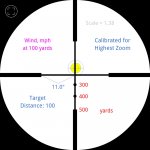Quickdraw, what did you like about Lowlights post. He said he "thinks" and it is "hard to say". He was trying to get the OP to clarify his question.
It implies right on the instruction for Leupold scope reticles that the POI will change. Example, variable power scopes with hunting reticles. Magnification is adjusted to match bullet drop. The Leopold LR Duplex and the Rifleman Ballistics reticles are the same reticle. Look up the pdf instructions. It's right there. You get your scope set at 6.5x to match the elevation marks on the scope and find it is accurate. You then change the magnification and now your POI has changed significantly. So yes, it is true but depending on your reticle it can be used to your advantage. It doesn't mean there is something wrong with the design of the scope. Also, if you have Strelok+ you can simulate this with that reticle tool Igor programmed into the app. The attachment with holdovers set at 200, 300, 400, 500 is set at 6.5x. The other one is set at 9x. These are for the same ammo. Notice the change in POI?




